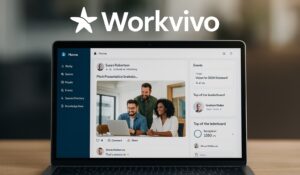A modern intranet platform is more than a repository of documents—it’s the core of a modern modern intranet platform strategy that helps organizations manage content at scale—it’s the modern engine behind how organizations communicate, manage knowledge, and keep employees connected. In this article, we break down what a CMS intranet is, how it works, and why it outperforms traditional intranets that were hard to maintain, static, and heavily reliant on manual page-building. Our goal is to help you understand how today’s CMS‑powered platforms streamline content, personalize experiences, and make internal communication significantly more effective.
👉 If you’re also exploring related platforms, see our employee intranet platform and our comprehensive intranet software guide for a list of top platforms.
What is a CMS Intranet?
One of the most common questions we get is “What exactly does a CMS intranet do?”. A CMS for intranet is a centralized, dynamic internal platform where employees can access information, tools, and communication tailored to their needs. Unlike traditional intranets—where every page had to be manually designed and updated—a CMS intranet uses templates, automation, and personalization to keep content consistent and relevant. Instead of maintaining dozens of static department pages or subsites, communicators focus on high‑quality content while the CMS handles design, layout, and distribution automatically.
A Brief Evolution of CMS Intranets
Early intranets in the 1990s functioned like simple internal websites that required coding skills to update. They lacked flexibility, weren’t visually appealing, and weren’t built for everyday content contributors. Over time, as browsers matured and content management systems became more accessible, intranets transformed into powerful platforms with templates, workflows, multimedia capabilities, and user-friendly content creation tools.
Today, the CMS in an intranet is the engine behind a highly organized and connected digital workplace. It allows teams to create, update, and share content quickly—without relying on IT.
How a CMS Intranet Works
A key question employees and leaders ask is, “How does a CMS intranet actually function day‑to‑day?”. A CMS intranet functions as the organization’s content engine—centralizing information, structuring it with metadata, and distributing it intelligently across channels and devices. Instead of storing files in scattered drives or relying on manual email updates, a CMS intranet brings everything into a governed, searchable system.
At its core, a CMS intranet enables teams to:
- Create and update content using reusable templates
- Organize information with metadata and tagging
- Automate publishing, approvals, and notifications
- Personalize content based on employee role, location, or team
- Collaborate through shared editing, comments, and workflows
Gartner predicts AI‑driven content governance will be standard in modern intranets by 2026 (source).
Modern platforms extend this further with AI-powered features that recommend content, summarize long posts, surface sentiment, and prompt authors to review aging information. This shifts the intranet from a passive storage tool to an active, intelligent communication layer.
Key Benefits of Using a CMS Intranet
If you’re wondering, “Why do companies invest in a CMS intranet?”—these benefits highlight the measurable improvements organizations experience across communication, productivity, and knowledge sharing. A modern intranet platform improves communication, strengthens alignment, and removes friction across the organization. Instead of employees guessing where to find information—or relying on tribal knowledge—a CMS intranet ensures content is accurate, consistent, and always up to date. Here’s what makes them indispensable:
According to Deloitte, organizations with strong internal social networks are 7% more productive (source). Gallup reports that highly engaged teams see 21% higher profitability (source).
Streamlining Internal Communication
Employees want timely, clear updates—and organizations need a reliable way to deliver them. A CMS intranet allows us to publish announcements, video messages, newsletters, and department updates in one central place. With structured categories and smart search, employees don’t have to dig through emails or outdated folders.
Centralizing Company Documents and Resources
When every team maintains its own storage system, information becomes fragmented. > IDC reports employees spend up to 2.5 hours daily searching for information (source). A CMS intranet drastically cuts this time by centralizing knowledge.
A CMS intranet gives employees one place to find:
- Policies and procedures
- Forms and templates
- Employee handbooks
- Department resources
- Training materials
With standardized formatting, metadata, and version history, information stays clean and accurate.
Enhancing Employee Collaboration
A CMS intranet makes it easier for teams to work together—even across locations. Employees can co‑create content, contribute updates, exchange comments, and share departmental pages. This reduces dependency on external communication tools and keeps conversations in context.
Simplifying Content Creation and Publishing
Legacy Approach:
- Writer drafts content in Word
- Sends to IT or a webmaster
- Webmaster rebuilds the layout manually
- Formatting breaks across subsites
- Multiple pages need separate updates
- Distribution happens manually through email
Modern CMS Intranet Approach:
- Writer selects a pre‑built template
- Adds text, images, or embedded media
- Approver reviews within workflow
- CMS automatically applies the layout
- Content appears for relevant groups instantly
- Notifications are automatically triggered
- AI generates summaries, snippets, and alternate formats
This shift transforms publishing from a slow, multi‑step task into a fast, repeatable, scalable process.
Legacy intranets treated every update like a mini‑web project. You had to format the page, adjust layouts, fix spacing, update menus, and hope everything displayed correctly across subsites.
With a modern CMS intranet, design is no longer the bottleneck. We use predefined templates, modular sections, and automated layouts so communicators can focus entirely on message quality. Once content is published, it automatically appears for the right audiences—no manual routing or duplication needed.
Instead of relying solely on IT, departments can use templates and workflows to publish their own content. This decentralization improves accuracy and keeps information fresh. Approval steps and permission controls ensure governance without slowing teams down.
Supporting Onboarding and Training
A cms employee portal can serve as a home base for new hires, helping them ramp up quickly with:
- Onboarding checklists
- Orientation content
- Training modules
- Culture and values pages
- Company-wide announcements
The result is a smoother, more engaging onboarding experience.
Improving Knowledge Sharing Across Teams
A CMS intranet enables employees to contribute knowledge across the organization—not just consume it. Subject‑matter experts can publish insights, update documentation, share best practices, and collaborate on resources. This “crowdsourced knowledge” model helps eliminate silos, accelerates learning, and ensures teams aren’t dependent on a small handful of content owners.
Boosting Employee Engagement and Productivity
When employees trust that the intranet is the single source of truth, productivity rises. They spend less time searching, make fewer mistakes, and feel more connected to the organization.
👉 For additional inspiration, explore more intranet communication examples.
Types of CMS Intranets
A common question is, “Which kind of CMS intranet is right for us?” This section outlines the major intranet types so teams can quickly compare options and choose the best fit.
Modern CMS intranets come in several forms, each offering unique strengths depending on your organization’s size, goals, and technical capability. Choosing the right type ensures your intranet scales with your needs rather than holding you back.
| Type of CMS Intranet | Description | Best For | Example Platforms / Companies |
|---|---|---|---|
| Traditional CMS Intranets (legacy on‑prem systems) | Early intranets hosted on internal servers; rigid, static, and require manual updates without personalization or AI. | Organizations tied to legacy infrastructure. | SharePoint (Classic), older Joomla installations, custom on‑prem intranets built by IT teams. |
| Headless CMS Intranets | Backend content management separated from frontend presentation, enabling content to be delivered to multiple devices and interfaces. | Companies needing fully custom interfaces or omnichannel content delivery. | Contentful, Strapi, Sanity.io (used to power custom intranet front ends). |
| Cloud‑Based CMS Intranets — see our guide on cloud intranet | Fully cloud‑hosted with easy access anywhere, reduced IT workload, and automatic updates. | Distributed teams, hybrid workplaces, and growing organizations. | Google Sites, Happeo, Simpplr, SharePoint Online. |
| Open‑Source CMS Intranets | Free, highly customizable platforms requiring strong internal developer resources. | Organizations needing deep customization with in‑house development. | Drupal, WordPress (with intranet extensions), Liferay Community Edition. |
| Proprietary CMS Intranets | Custom‑built systems tailored to specific needs; powerful but costly to maintain. | Enterprises with niche requirements and dedicated engineering teams. | Custom‑built enterprise intranets developed by internal IT or agencies. |
| Modern CMS Intranet Platforms | SaaS solutions offering AI, automation, templates, integrations, and continuous enhancements with minimal maintenance. | Organizations seeking fast deployment, modern UX, and long‑term scalability. | HubEngage, Staffbase, LumApps, Firstup, Interact Software. |
Essential Features of a CMS Intranet
For teams comparing tools, explore our guide to the best intranet apps to see how mobile‑first intranet experiences complement a CMS intranet.
People often ask, “What features should a modern CMS intranet include?”. A strong modern intranet platform includes foundational tools for content and workflow management—but modern platforms introduce more advanced capabilities that elevate the employee experience.
Core Features
- Drag‑and‑drop content editor
- Reusable templates for consistency
- Document and version management
- Metadata and advanced search tools
- Mobile app access for distributed teams
- Role‑based permissions and governance
- Automated publishing workflows
- Analytics for content performance and engagement
Advanced Features Found in Modern Platforms
- Native video hosting for training and communication
- AI‑powered personalized feeds and recommendations
- Automated author reminders for aging content
- Sentiment analysis to detect employee concerns
- Personalized dashboards with to‑dos, news, and resources
- Integrations with HRIS, communication apps, project tools, and data systems
- Auto‑governance to prevent outdated content from accumulating
These enhancements help organizations scale communication, eliminate content bloat, and keep the intranet fresh and relevant.
CMS Intranet vs Traditional Intranet
Organizations exploring an upgrade often ask, “How is a CMS intranet different from our old intranet?”
Traditional CMS intranets played a major role in the early digital workplace—but they were limited by rigid interfaces, static layouts, and manual maintenance. Modern CMS intranets evolve far beyond that, integrating AI, automation, and advanced personalization.
How Traditional and Modern Platforms Differ
Legacy intranets were often limited to:
- Updating knowledge base articles
- Searching employee directories
- Posting calendar events
- Publishing static newsletters
Modern CMS intranets, in contrast, support:
- Dynamic, role‑based content recommendations
- Personalized employee dashboards
- Native video learning experiences
- Employee recognition and social engagement feeds
- Intelligent governance to maintain fresh content
- Integrations across HR, IT, communication, and productivity tools
This shift transforms the intranet from a simple document repository into a dynamic employee experience platform.
Legacy Intranets vs Modern CMS Intranets
The table below highlights how traditional intranets focused on layout and structure, while modern CMS intranets focus on content, relevance, and scalability.
| Capability | Legacy / Traditional Intranets | Modern CMS Intranets |
|---|---|---|
| Page creation | Manual, page‑by‑page builds | Template‑driven, modular blocks |
| Maintenance | High—changes repeated across subsites | Low—global changes update everywhere |
| Personalization | Minimal or non‑existent | Automated, rules‑based personalization |
| Notifications | Manual emails, no automation | Automated email, push, and in‑app alerts |
| Search | Basic, often unreliable | Metadata‑rich, AI‑enhanced |
| Collaboration | Limited to none | Real‑time co‑authoring, comments, workflows |
| AI capabilities | None | Summaries, recommendations, translations, tagging |
Traditional intranets weren’t just static—they were heavy, rigid, and incredibly difficult to maintain. Before CMS‑powered platforms existed, communicators had to design and layout every single page manually. Each department often required its own subsite, its own navigation, and its own design structure. That meant more work, more inconsistencies, and more maintenance.
With legacy intranets:
- Every new section required building pages from scratch
- Small updates—like changing a header or a link—had to be replicated across multiple subsites
- Layouts dictated the experience, not the content
- Communicators spent most of their time fixing pages instead of engaging employees
A modern CMS intranet flips this completely. Instead of managing pages, we manage content. Templates, dynamic widgets, and automated personalization do the heavy lifting.
With a modern CMS intranet:
- Communicators focus on writing relevant content—not designing layouts
- Publishing is simplified with templates and drag‑and‑drop blocks
- Changes update automatically across pages and channels
- Content is delivered automatically to the right people based on role, location, team, or interests
- Email, push, and in‑app notifications are triggered instantly
- AI generates summaries, translations, and recommendations
This shift—from building pages to delivering personalized content—is what makes CMS intranets dramatically more scalable, efficient, and impactful.
How to Choose the Right CMS Intranet for Your Organization
Leaders evaluating solutions frequently ask, “What should we look for in the best intranet CMS guide)?” This section provides a practical checklist for selecting the right platform.
When selecting the best intranet CMS, consider:
- Ease of publishing for non‑technical users
- Integration with your HRIS, communication tools, and file systems
- Strength of search and metadata
- Personalization options
- Mobile accessibility
- Security and compliance
- Scalability for future needs
- Automation and AI capabilities
The right platform should support growth while simplifying daily operations.
Best Practices for Implementing a CMS Intranet
Teams often wonder, “What does a successful intranet implementation look like?” These best practices guide organizations through launch, governance, and long‑term optimization.
Implementing a CMS intranet requires thoughtful planning, ongoing governance, and continuous optimization. For more detailed guidance on rollout strategy, see our resource on company intranet implementation. These best practices ensure both a successful launch and long‑term adoption:
- Define clear objectives: Clarify the problems you want the intranet to solve.
- Gather requirements: Involve employees, HR, IT, and leadership to shape functionality.
- Choose a user‑friendly platform: Look for intuitive design, strong templates, AI features, and a shallow learning curve.
- Train and onboard users: Use webinars, micro‑videos, or staged rollouts to build comfort and confidence.
- Implement governance: Assign roles for content creation, approval, and lifecycle management.
- Maintain regularly: Use governance tools, analytics, and reminders to keep content fresh.
- Encourage engagement: Promote sharing, commenting, and contributions from employees.
- Continuously improve: Review analytics, gather feedback, and iterate based on usage patterns.
A CMS intranet is not a one‑time project—it’s an evolving digital workplace environment that grows with your organization.
Real-World Examples of CMS Intranets
A question many buyers ask is, “How do other companies actually use their CMS intranet?” These examples illustrate common use cases across industries and team structures.
Organizations across industries rely on CMS intranets to streamline operations, support distributed teams, and strengthen culture.
Common Use Cases
- Serving as the “front door” to a company’s entire tech stack
- Delivering personalized dashboards with news, tasks, and resources
- Supporting onboarding through guided checklists and role‑based training
- Offering centralized access to HR information like pay, benefits, and PTO
- Providing native video training libraries
- Centralizing compliance, safety, and SOP documentation
- Helping distributed or remote teams stay connected through social feeds and engagement tools
Industries like healthcare, manufacturing, retail, hospitality, government, and higher education often depend heavily on CMS intranets because they simplify communication across complex, multi‑site workforces.
Future Trends in CMS Intranet Platforms
Forward‑thinking organizations ask, “How will CMS intranets evolve over the next few years?” This section highlights the emerging technologies shaping the future of employee experience platforms.
CMS intranets continue to evolve as workplaces become more digital and distributed. We’re seeing increased use of:
- AI‑powered search and recommendations
- Automated content lifecycle management
- Role‑based personalization
- Multichannel delivery (email, SMS, push, Slack, Teams)
- Social and gamified engagement features
- Deeper integrations with employee experience platforms
These trends point toward intranets that are smarter, more interactive, and more deeply embedded into everyday workflows.
Conclusion
A modern intranet platform or cms employee portal is essential for any organization aiming to streamline communication, improve content governance, and support a unified digital workplace.
An intranet with a modern cms gives organizations a powerful way to centralize information, improve communication, and enhance collaboration. By unifying content across teams and channels, companies can reduce confusion, remove duplication, and create a more productive, engaged workforce.
Whether you’re evaluating a cms for intranet, comparing options to find the best intranet CMS, or exploring how a cms employee portal can modernize your digital workplace, choosing the right platform can transform the way employees access information and work together.
FAQs
What is the purpose of a CMS intranet?
A CMS intranet serves as the central hub for all internal communication, content, and organizational knowledge. It ensures employees have one reliable source of truth for policies, procedures, updates, and tools. Instead of relying on scattered drives, email chains, or tribal knowledge, employees can quickly find accurate information through search, metadata, and structured pages. It also provides the infrastructure for collaboration, workflows, governance, and personalized communication across the company.
How does a CMS intranet improve employee engagement?
A CMS intranet improves engagement by delivering relevant content to employees based on their role, location, and preferences. When people consistently receive updates that matter to them—and can easily contribute ideas, share feedback, and participate in discussions—they feel more connected to their teams and their organization.
It makes communication clearer, information easier to find, and the work experience more connected.
Can a CMS intranet integrate with third-party tools?
Yes. An intranet platform with CMS integrates deeply with HRIS systems, SSO and identity providers, payroll platforms, document storage tools (SharePoint, Google Drive), communication apps (Slack, Teams), LMS platforms, project management systems, and workflow automation tools. These integrations turn the intranet into a single digital front door—reducing app switching, improving operational flow, and ensuring employees always know where to go for information.
What are the security features of a CMS intranet?
A CMS intranet includes enterprise‑grade security features designed to protect sensitive company information. These commonly include SSO and MFA authentication, role‑based access permissions, encryption at rest and in transit, audit logs, secure hosting environments, and compliance with standards like SOC 2, ISO 27001, and GDPR. Modern systems also include governance tools that prevent outdated, duplicate, or unauthorized content from being published or accessed. See our guide on Intranet Security.
How do you measure the success of a CMS intranet?
Success is measured using a blend of engagement analytics and operational outcomes. Key indicators include user adoption rates, active daily or monthly usage, content performance metrics, search success rates, reduced internal email volume, faster onboarding times, and employee sentiment. A strong modern intranet platform should also reduce time spent searching for information, decrease duplication of work, and improve alignment across teams.
How do you implement a CMS intranet in an organization?
Successful implementation begins with defining clear goals, understanding employee needs, and mapping out a scalable content governance model. Organizations should assign roles for owners, editors, and approvers; migrate and modernize existing content; establish a taxonomy and metadata structure; and configure templates and workflows. Training and change management are critical. A strong launch campaign—combined with analytics‑based iteration—ensures adoption and long‑term success.
What challenges do companies face when adopting a CMS intranet?
Common challenges include low adoption due to unfamiliarity or change resistance, unclear ownership of content, outdated or inconsistent information, and poor governance structures. Some organizations underestimate the need for an ongoing content strategy, analytics monitoring, and lifecycle management. Ensuring the intranet stays fresh, relevant, and easy to use requires intentional planning and periodic optimization.
What’s the Difference Between a CMS Intranet and a Knowledge Base?
A knowledge base is a structured repository for FAQs, product documentation, troubleshooting guides, and standardized answers. It is designed for fast retrieval of information. A modern intranet platform, on the other hand, is a broader communication and collaboration ecosystem. It includes social engagement, workflows, multimedia publishing, personalized feeds, document management, and system integrations. A knowledge base can exist within a CMS intranet—but the intranet supports far more comprehensive workplace functions.
How can you measure the ROI of a CMS intranet?
ROI can be measured through reduced time spent searching for information, fewer internal emails, and streamlined communication. A CMS intranet also consolidates redundant tools, reduces IT workload, improves onboarding speed, increases employee engagement, and strengthens alignment across teams. Many organizations see measurable ROI by comparing productivity before and after launch—especially when replacing outdated or fragmented intranet systems.













